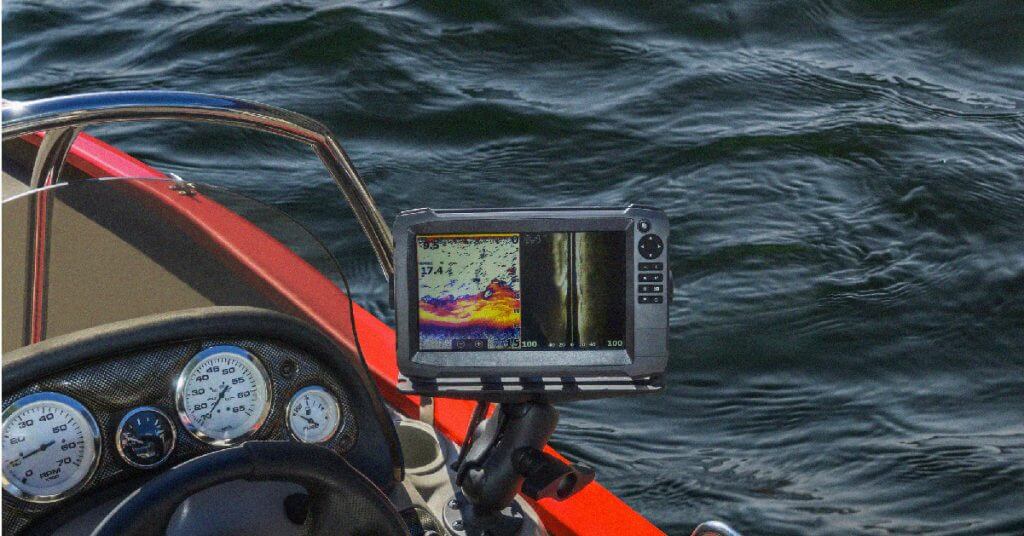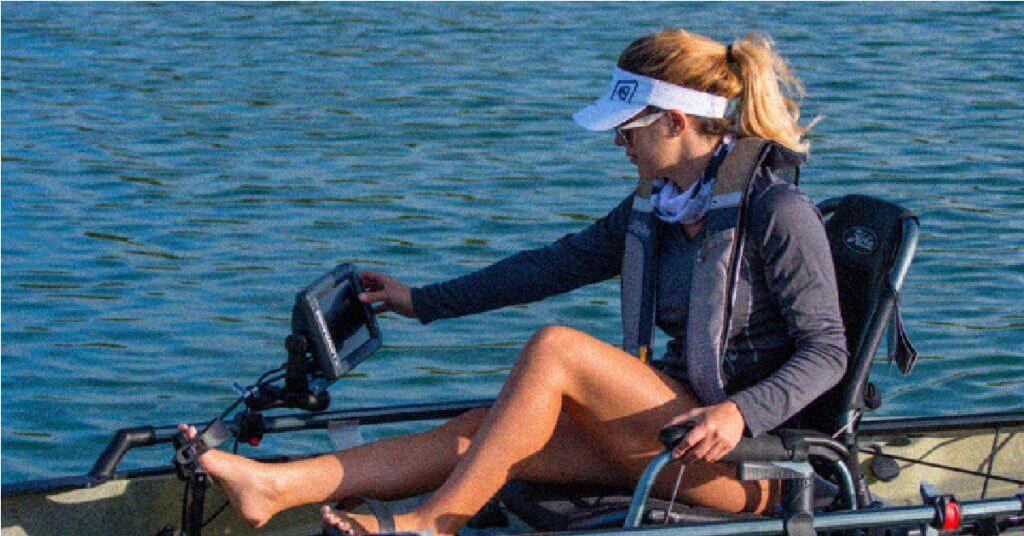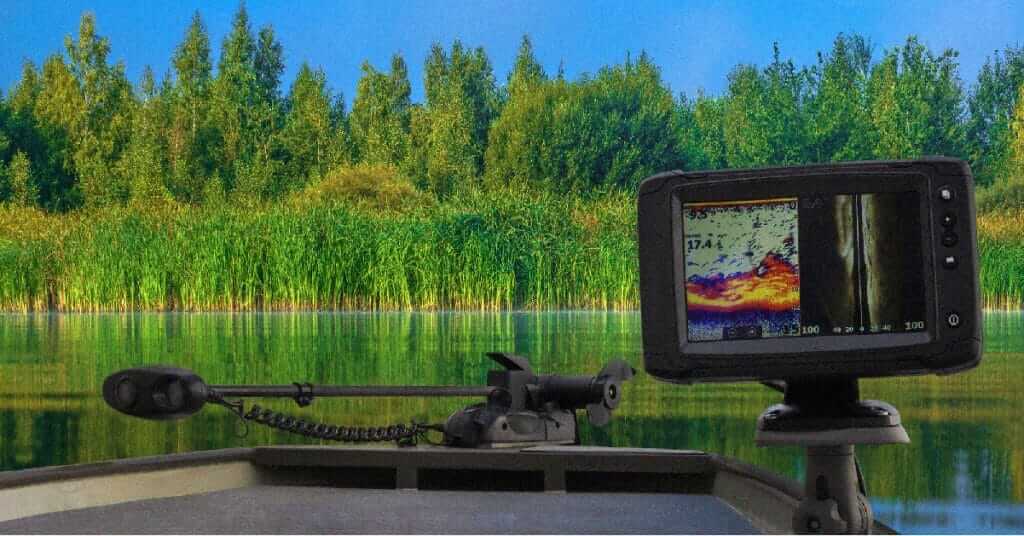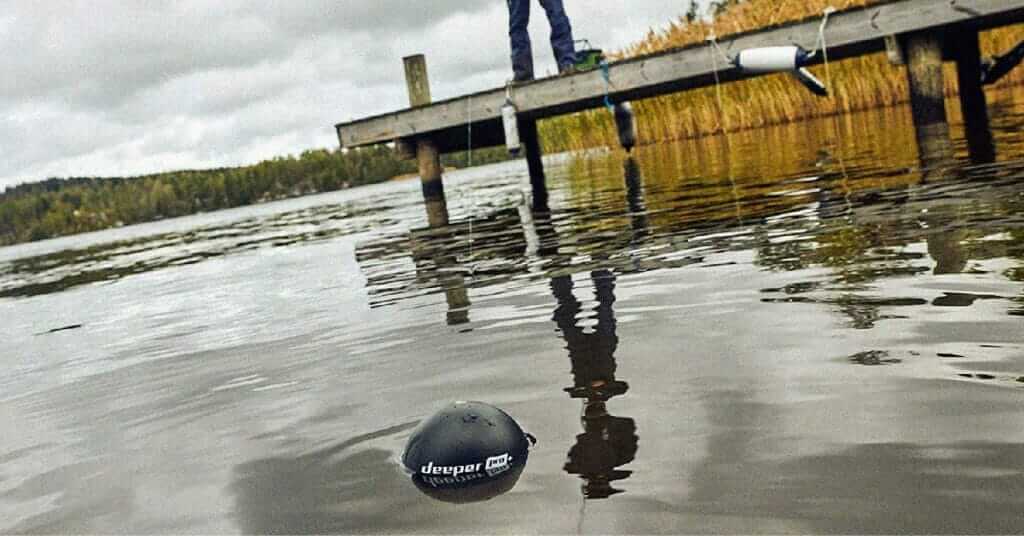We independently research, test, and recommend the best products; you can learn more about our review process here.
Whether you’ve fished for 40 years or 4 minutes, someone is out there catching more fish because they’re using the best fish finder on the market. But what determines the best fish finder?
Honestly, there are so many factors that determine which fish finder you should buy, I’d have to write a book to cover them all.
So instead of wasting your time reading about features you could care less about, I’ve taken the liberty to use this article to point you to articles that are tailored for your specific needs.
Whether you fish from the bank, kayak, small boat, freshwater, or saltwater, or anything in between we have you covered from bow to stern.
Don’t worry I’ve still reviewed the best fish finders at the bottom of this article if you’re curious which one I think is the best for the widest variety of anglers.
Top 3 Best Fish Finders on Today’s Market
For all the anglers in a hurry, here are my top three picks based on days of testing and weeks of researching:
Table of Contents
Best Fish Finders by Fishing Method
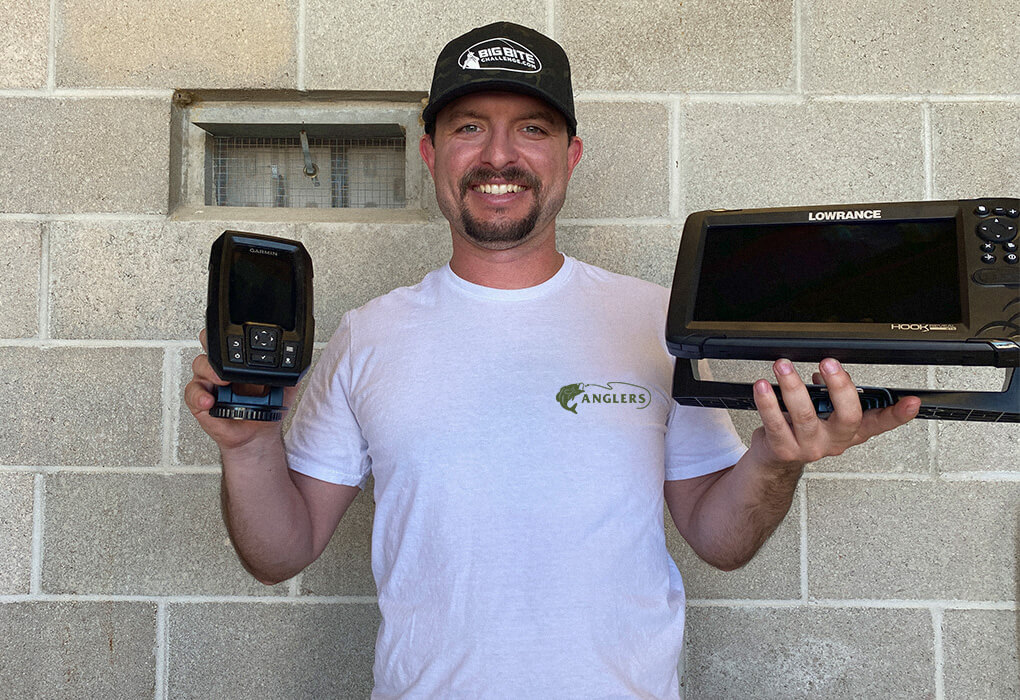
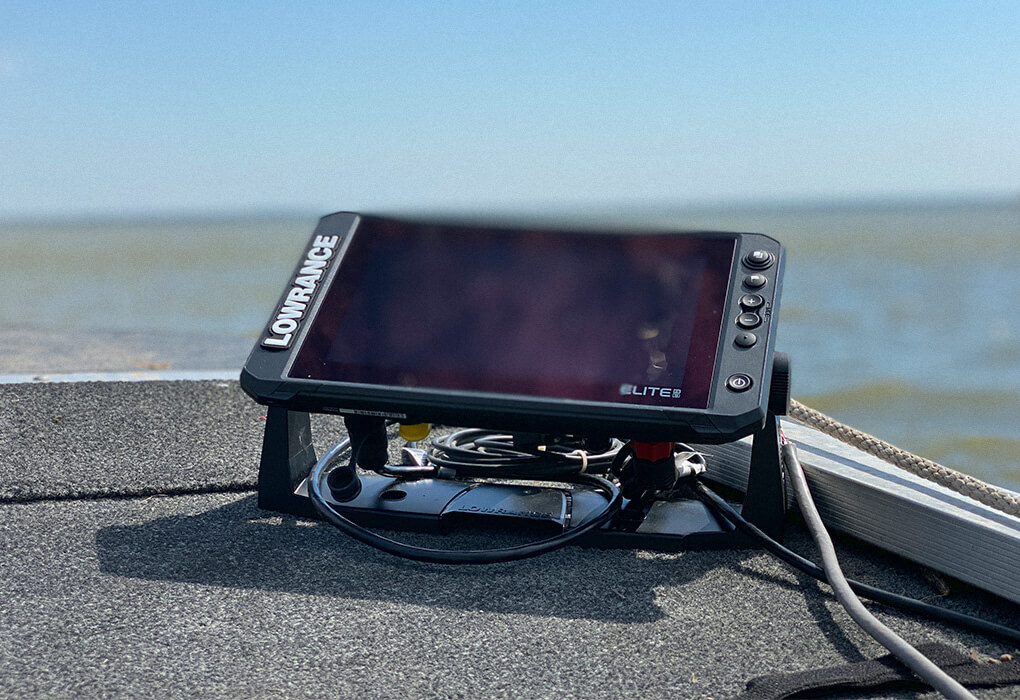
Wesley on the water testing out fish finders
Your fishing method is the most important consideration. Are you planning to fish from the shore or from a boat?
These two scenarios require two very different fish finders. So below, you’ll find how our anglers have ranked fish finders based on how they’ll be used.
We’ve linked our other fish finder articles based on your situation, so as you continue reading, those articles will be able to point you in a much more specific direction.
Kayak Fish Finders
The best kayak fish finders are smaller and require fewer features than the ones we find on bass boats. However, that doesn’t mean they’re pointless and lame.
You can still have the latest and greatest technology on your kayak, if you’d like.
Fish Finder For Jon Boats
Similar to a kayak fish finder, the best fish finders for small boats need to be compact without sacrificing all the features we’ve come to love like Down Imaging, Side Imaging, and Live Sonar.
However, you also likely don’t want a fish finder that costs more than your boat did, so there’s a delicate balance to maintain.
Pontoon Boat Fish Finders
The best fish finder for pontoon boats isn’t what you think because due to the unique profile of pontoon boats, they require some special adaptations when mounting your fish finder’s transducer.
Also, pontoons are not solely fishing boats, so you likely don’t need the high-end fish finders found on bass boats.
Fish Finder for Crappie
The best fish finder for crappie fishing is the same as with any other type of fishing. However, crappie anglers have specific features they should look for when buying a new fish finder.
My favorite is live sonar! Nothing beats pulling up to a brush pile, scanning it to see if there’s any fish on it and how they react to my lure.
Fish Finder for the Ice
Some of the most unique fish finders are for ice fishing. The best ice fishing fish finders need to be accurate, portable, and durable to withstand the nasty elements faced by ice fishermen and women.
Don’t be left out in the cold!
Bank Fishing Fish Finder
Yes, there is such a thing as the best fish finder for bank fishing and they’re surprisingly portable, accurate, and give shore anglers the ability to see structure and fish they otherwise would have missed.
The best castable fish finders won’t force you to get your feet wet to use them!
Saltwater Fish Finder (Fish Finder/GPS Combo)
Choosing the best fish finder GPS combo always provides unique challenges that most freshwater anglers rarely understand.
Not only do you need something that can resist the corrosive nature of saltwater, you also need a unit that has incredible accurate mapping and weather tracking capabilities on top of all the other features freshwater anglers use.
Fish Finders by Brand
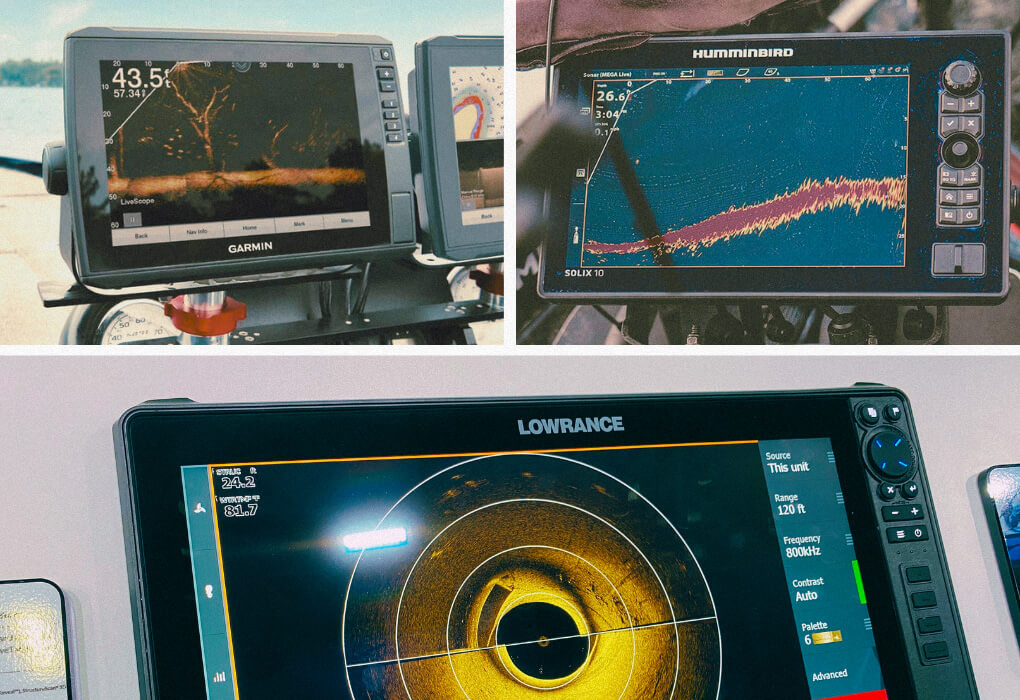
Another consideration I make before buying a fish finder is which brand do I prefer. While each fish finder brand has some stand-out features, they all generally do the same thing.
I’ve talked with pros and other weekend anglers, and we all have our opinions as to how we justify spending thousands of dollars on this technology in our boats and kayaks and why the other brands don’t stack up.
That’s why I say it’s mostly a personal preference.
Garmin
Garmin is a leader in the GPS/Mapping space and has been leading the advancement of fish finder technology for decades.
Garmin is the brand I have installed on my kayak and countless saltwater and freshwater pros trust it for their livelihood. Few others stack up against the best Garmin fish finder.
Lowrance
Lowrance is one of the most trusted brands in the fishing industry. The best Lowrance fish finder won’t disappoint. I’ve used many Lowrance fish finders and helped install one on my grandpa’s small fishing boat.
Humminbird
The best Humminbird fish finders give anglers more advanced features at a lower price. They’re known for making excellent ice flashers on top of having the latest sonar capabilities on their fish finding units.
Fish Finders by Sonar Type
Today’s fish finders have a ridiculous number of features, often overshadowing the most important feature, the sonar, the stuff that actually helps you find fish to catch.
Live Imaging
Live scanning sonar is the latest and greatest sonar technology. If you haven’t used it yet, you’ll be blown away by what it does in terms of showing you the fish and how they react to your bait.
Sometimes the names of real-time live sonar get confusing or interchanged by anglers, so here they are according to the brand:
Garmin Panoptix Livescope
Garmin Panoptix Livescope was the first live sonar to the market and is still considered to be the best by many anglers.
Humminbird Mega Live
The Humminbird Mega Live is perfect for the anglers already using Humminbird electronics. However, it’s known to have some issues.
Lowrance Active Target Live
If you’re a Lowrance user, don’t worry, you too can use live sonar with Active Target Live, it’s nearly identical to Panoptix Livescope.
360 Imaging
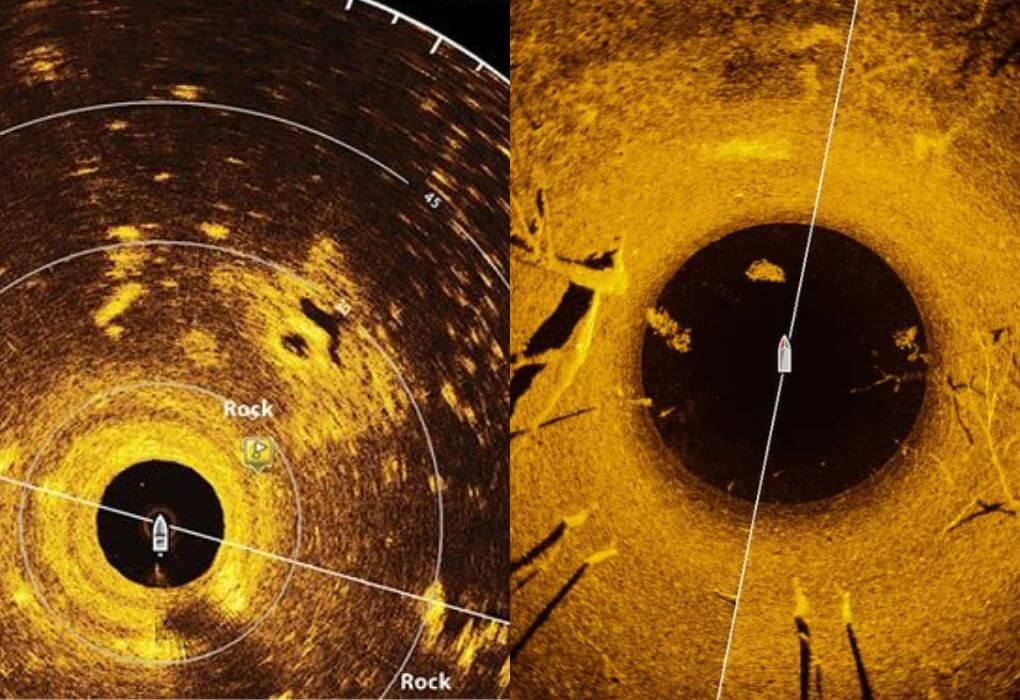
360 Imaging has been around for a while and is basically a rotating side imaging sonar or sidescan and downscan combined to see a 360-degree view of everything around your boat.
It’s not as popular as live sonar, but it definitely gives you a competitive advantage over the fish and other anglers.
Side Imaging
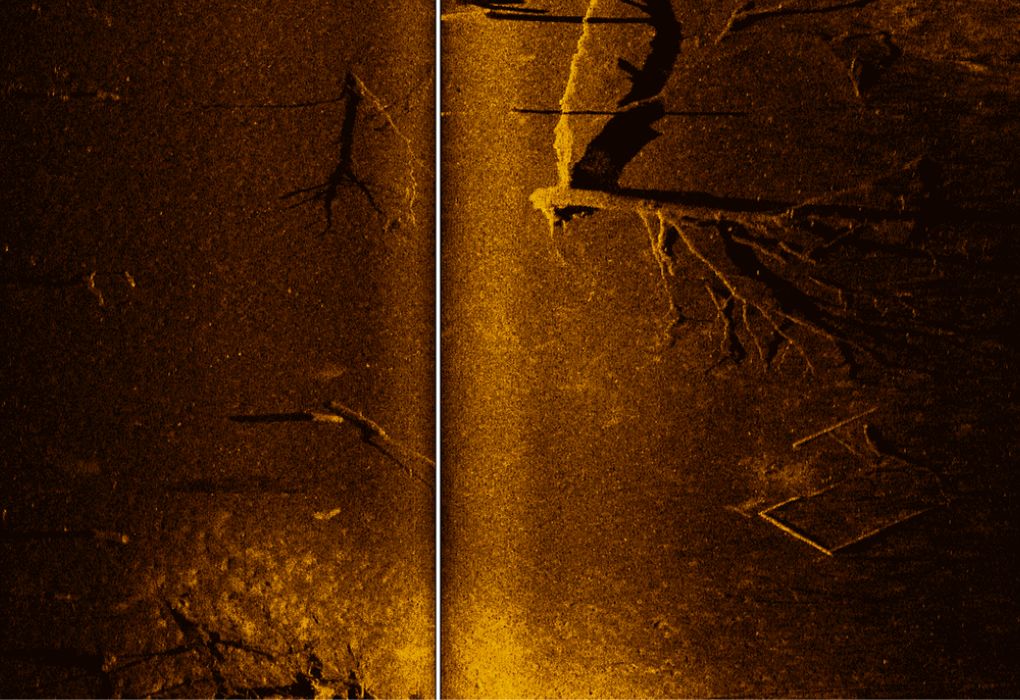
Side imaging allows you to see the structure to the side of your boat. It’s been around for decades but is still incredibly useful for finding fishy spots that most overlook.
Each brand calls it by a different name, which might get confusing:
- Garmin – SideVu
- Humminbird – Side imaging
- Lowrance – SideScan
- Raymarine – SideVision
Each side imaging fish finder will have a certain radius that it can read, and the best fish finders will offer a combination of all of these in one.
You’ll get CHIRP, down image, and side image in one convenient package to hook up to your boat and roll with.
If you’re new to fish finders and need a more in-depth explanation, I highly suggest reading our guide on how to read a fish finder.
Down Imaging
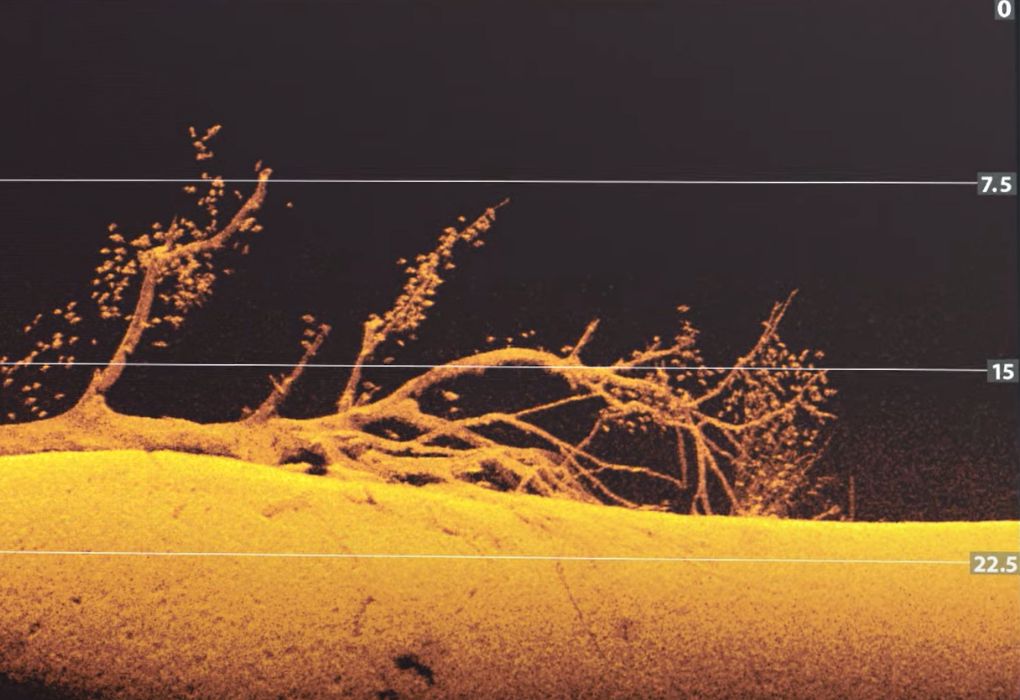
Down imaging is similar to side imaging, except it shows you what’s directly below your transducer.
Once again, each brand has a different name for it, but it’s pretty straightforward:
- Garmin – DownVu
- Humminbird – Down Imaging
- Lowrance – DownScan
- Raymarine – DownVision
Instead of creating images based on where the sound bounces off, this type of sonar will paint a vivid picture of what to expect beneath the water based on the frequency.
Down imaging sonar provides an elaborate picture of underwater structures such as trees, stumps, and greenery.
It also refreshes constantly, so it will continue to pick up the movement of fish as they move around beneath you.
These are much more accurate and keep you hot on the trail of fish. The problem is they can only tell you what is directly beneath the boat.
These work well if you’re throwing out a split shot or drop shot, but if you’re trying to cast long distances underneath a dock, you won’t have any idea what’s out there.
Best Fish Finders by Price
Whether you’re looking to purchase the cheapest fish finder or the best fish finder for the money, we have you covered.
Just because you have a tight budget doesn’t mean you should settle for a low-quality fish finder or go without a fish finder.
Everything You Have to Know Before Buying a Fish Finder
When choosing the right fish finder, many people don’t realize that it has a lot less to do with the design, screen, and appearance of the unit itself, though all these are important considerations that we’ll discuss later.
But choosing the best fish finder transducer will separate the top-rated fish finder from a scrub you find on Amazon.
Transducer
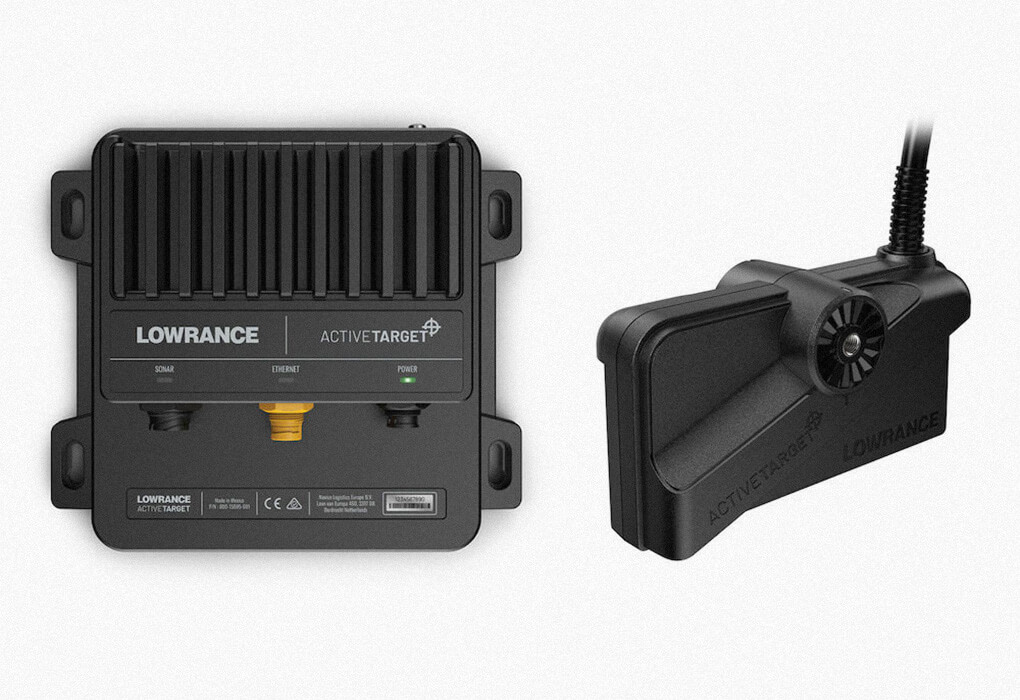
The transducer is an essential component because it will determine the quality of the image you receive. If you don’t have a high-performing transducer, you won’t have the accuracy you need to find anything.
The transducer sends the sonar waves into the water, and those waves bounce back; that’s what provides you with the image of a fish underneath the boat. So, how do you tell that you have a high-quality transducer?
First, I look at the brand. If it’s a popular brand like Humminbird or Garmin, I know I’m getting a product with a successful reputation.
The next thing I look at is the build of the device. Does it appear durable? Does it look like it can withstand some abuse?
Keep in mind that this piece will usually get mounted on the underside or side of the boat. There’s a chance that it might take some damage in the water. It needs to be able to hold up against all the odds.
Mounting the Transducer
Another important factor to consider is how the transducer gets mounted to the boat. The typical type of mount is a transom mount transducer.
These are mounted to the back of the boat so they don’t have to take a heavy flow of water.
Through-hull mounts usually go inside the boat, and while they’re more durable and offer more flexibility as to where you mount them, they’re more expensive.
These are designed for longer fishing trips in deep water on higher-speed boats.
An in-hull mount goes inside the boat, as the name suggests, and they’re easy to install. The downside is that you need a boat material that the transducer can penetrate.
You’ll need to mount it using bronze, stainless, or plastic based on your boat’s material.
Transducer Cone Angle
The cone of your fish finder refers to the width of the sound wave it offers. The wider the cone, the larger the area. It’s important to understand that larger doesn’t always mean better.
Some of the fish finders we will look at below have a wide radius, but that results in a poorer signal in deeper water.
I’ve noticed that fish finders with a smaller cone provide a much clearer and more accurate picture of what’s going on under the water.
Where you really want to pay attention is the depth of the cone. Some will only provide signals up to 100 feet at the side but 150 feet if you’re directly under the boat.
If you don’t understand this, it can lead to distortions and confusion, which can cause you to cast in places where you won’t catch anything.
The angle of the cone is critical too, and you’d like to find one with at least a 20-degree angle. These are the most common, and you shouldn’t have to pay a whole year’s salary to get one that offers it.
Many of the fish finders I reviewed and tested below also offer dual spectrum chirp, which will cover more area at a shallower depth.
Frequency of the Transducer
Another factor that will determine the quality of your image is the transducer’s frequency. Higher frequencies mean more detail.
The primary thing to understand is that, with a high frequency, the water depth and power decrease. So, ideally, you want to find something with a nice middle ground.
Most transducers today offer multiple frequencies, so you can switch to the one that best suits your needs at the moment.
Quality frequency and moderate power are essential to getting a high-quality picture of what’s under the water.
Power
When I refer to power, I’m talking about the power of the transducer. The amount of power you have will determine how deep your finder can display images.
A powerful device will allow you to work better in deeper water, but it will also help you in less-than-desirable conditions.
If the water is murky, a low-quality fish finder will prevent you from getting a clear image.
The power of your transducer is calculated in something called RMS or root mean squared. It’s similar to wattage. Most fish finders aren’t any less than 200 RMS, and the ideal power is 500.
If you have a 500-watt device, you will be able to get a clear image in any condition.
Sometimes it’s not even about the image. Many finders today need a lot of power to display water temperature, depth, GPS, and all the other features they offer. So you’ll need a lot of power for your transducer and for the unit.
When you’re looking for the ideal fish finder, there are many features to keep an eye out for, from the transducer to the display and everything in between. The following are some examples.
Display
The display and screen you get with your fish finder are important because it helps you see what’s happening beneath you.
An important feature that I look for is a fish finder with a display that is easy to navigate. A split screen is also an ideal feature.
I’m looking for simplicity, as should you. All I need is a fish finder that will help me find fish. It’s all part of the user experience.
Even though simplicity is important, you still need the perfect number of features. Having depth finders will help you scope out the water and identify ideal fishing locations.
Something else you want to look for with your display as well as the type of screen. Some are monochrome, while others are color.
Most of the fish finders we see today will use full-color displays to signify changes in elevation; this feature is incredibly useful and helps you get an idea of what you’re looking at faster.
You also want to look for a display that offers some sort of glare protection on the user interface. This will make it easier to see regardless of the conditions. A backlight is convenient for night fishing as well.
Screen Resolution
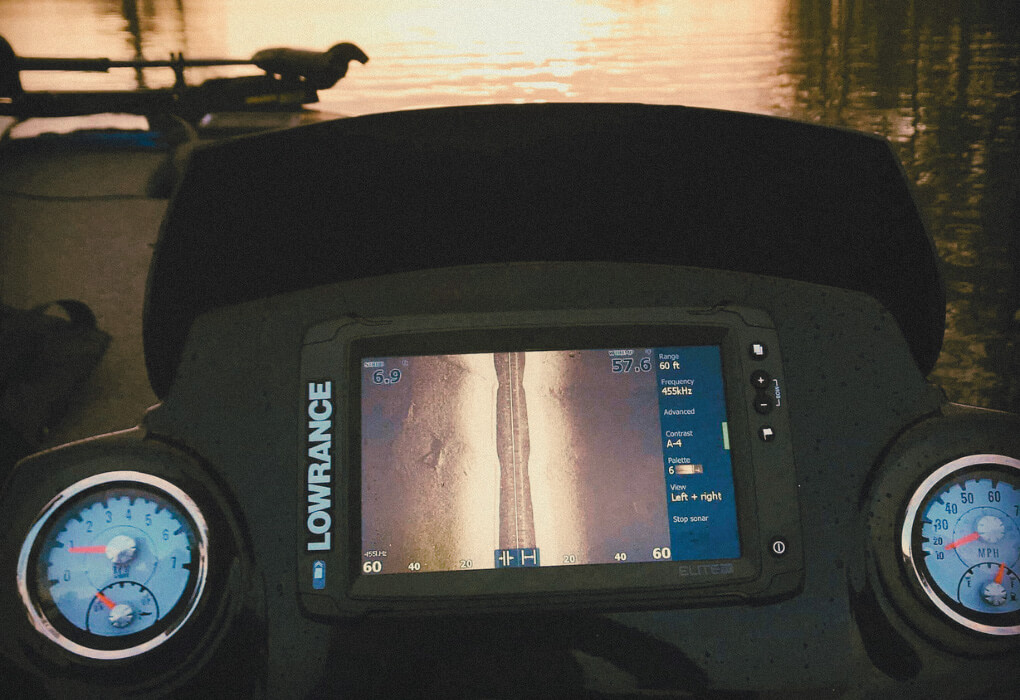
Your screen’s resolution is always an important buying factor because it determines how much time you’ll have to spend looking at the fish finder to figure out what you’re looking at.
While there’s no “set in stone” requirement for screen resolution, you want something with high resolution that allows you to read the fish finder clearly.
Size
I want something that isn’t intrusive to my fishing. I find that some of the fish finders reviewed below take up a lot of space in a small boat or kayak.
Nobody wants something that gets in the way.
That said, the smaller you go, the smaller screen size you will get, which may make it more difficult for you to see what’s happening underwater.
You’ll want to weigh the pros and cons here. If you have a small boat, you’ll have to either sacrifice some space or get a smaller fish finder.
GPS Capabilities
You want a GPS fish finder because this is a feature you won’t realize you need until you need it. If you’re out on the water and a dense fog comes rolling in, you won’t know where you are.
I’ve drifted too far down the river on multiple occasions that I can’t determine how far it is back to the launch site. If that happens, I can check out the GPS and keep my peace of mind.
A GPS fish finder also allows you to create waypoints, and many have chartplotter features so you can document your best fishing spots for next time.
The only problem with the GPS fish finders combos is the price.
These are more expensive and sometimes a little bulkier, but you can’t sacrifice the security you have in always knowing where you are. (unless you have GPS on your phone, which most of us do, but what happens when your phone dies?)
Personal Reviews Of The Best Fish Finders
Garmin Echomap UHD2
BEST FISH FINDER OVERALL
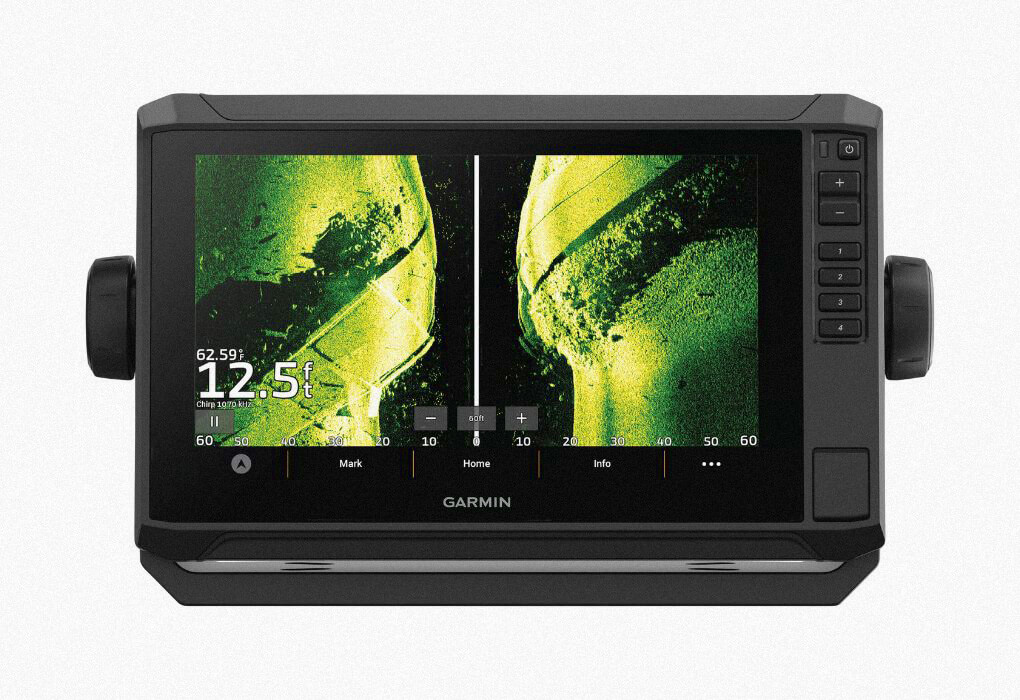
Specs
- Sonar Type: SideVu, ClearVu, CHIRP, and Livescope compatible
- Screen Sizes: 5”, 6”, 7”, or 9”
- Resolution: 1024 x 600 pixels
Pros
Cons
Why We Chose It
The Garmin Echomap UHD2 is hands down the best fish finder I’ve ever used. It’s the newer model of the Garmin Echomap UHD, which I love having installed on my kayak.
This is the best unit for serious anglers because we can add the greatest sonar technology on the planet, Panoptix Livescope, to our sonar setup, plus it has an even better screen than the previous UHD model (which was already solid), and you’ll never get lost with Garmin’s world-renowned mapping.
I love using Livescope when fishing because, unlike traditional sonar, Livescope gives you a live view of what’s happening below the water, so you can see exactly how the fish react to your lure and adjust accordingly to get more bites.
Don’t worry; if spending another $1500+ on Livescope seems absurd to you, the ClearVU and SideVU sonars offer a crystal clear picture of structure on the bottom, which allows you to find where the fish are quickly, so you can spend more time catching fish and less time trying to find them.
I love that Garmin gives anglers several different screen size options, 5”, 6”, 7”, and 9”.
However, the 5” screen is not a touchscreen, nor is it capable of all the features of the larger screens, which is why I recommend getting at least the 7” screen if you’re a serious angler.
Otherwise, you should get a Garmin Strike Vivid 5.
Dedicated anglers also love the ridiculously clear 1024 x 600-pixel screen that you can see just as easily on bright sunny days as you can when it’s cloudy.
Never again can the weather be your excuse for not finding the fish. Guess that means I better start coming up with some more!
Since we’re on the topic of finding fish, finding and marking your favorite fishing spots is easy as pie with this chartplotter.
You get the wildly popular Garmin Navionics mapping with the UHD2, and you can add more memory with a 32G microSD card, so you’ll always have exactly where you caught your fish.
I promise you’ll never wonder where you’re at again, but all the other anglers sure will be! So don’t let that one guy who’s always snooping at the boat ramp get too close to your maps!
While I think this is the best unit available, it still has some cons that you must be aware of before investing your money in it.
The first and most obvious is the high price.
Because this unit is packed with incredible features, it comes at a steep cost that’s difficult to justify for many anglers.
The UHD2 5” screen is under $500, but it doesn’t have all the features of the others, so you’ll have to spend around $1,000 to get SideVU & ClearVU, then another $1,500+ to get Panoptix Livescope.
The dollar bills add up fast, and pretty soon, you’re slurping down Ramen noodles for the next six months to pay for it all. That’ll make you feel like you’re in college again!
The other downside I found is if you’re a newbie to fish finders, you’ll probably be confused by the number of features. I sure was at first, and I tested several others before this one.
However, with a basic understanding of technology, it’s a quick learning curve.
Despite the cons of the Garmin Echomap UHD2, it’s still the best fish finder because it’s compatible with the best sonar from Garmin in multiple screen sizes at an understandable price.
The Garmin Echomap UHD2 is the perfect sonar system for the serious angler, so order one today.
Don’t miss our Garmin Echomap UHD2 review to discover everything this unit has to offer.
Lowrance Hook Reveal
BEST FISH FINDER FOR CASUAL ANGLERS
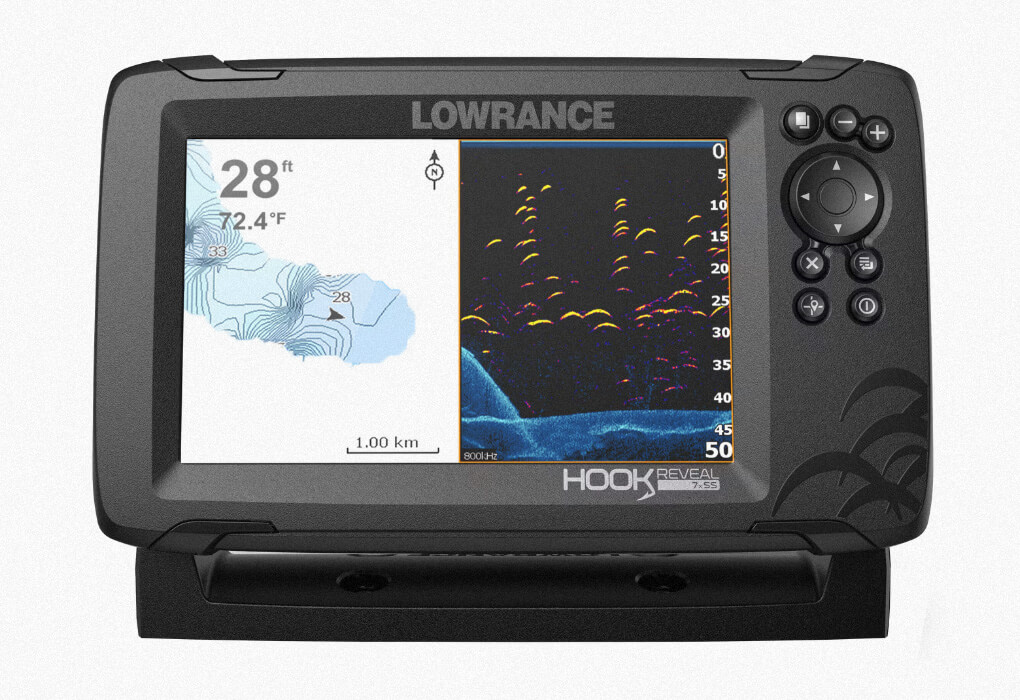
Specs
- Sonar Type: DownScan, SideScan, Traditional CHIRP
- Screen Sizes: 5”, 7”, or 9”
- Resolution: 800 x 480 pixels
Pros
Cons
Why We Chose It
The Lowrance Hook Reveal is the perfect fish finder for regular anglers who want a high-quality fish finder at an unbeatable price.
With the SolarMAX display, FishReveal Technology, and the Tripleshot transducer, you’ll be hard-pressed to find a better fish finder at this price.
When I told my grandpa about the features it offered at the ridiculously low price, he had to have one, so we installed one on his 16’ 1989 Bass Tracker we use for crappie fishing and trolling on the river.
My grandpa, who wears glasses, thinks the screen is easy to see, even in the sunlight, thanks to the SolarMAX display.
For the anglers learning how to read a fish finder, you’ll appreciate the FishReveal Technology, which previous Lowrance Hook2 models didn’t have, because it highlights the sonar arches that are fish, making it easier to tell between a brush pile or a school of fish.
During my testing, I found many reasons to love the Tripleshot transducer; the biggest is it keeps the installation process simple.
Mount the transducer to your boat, run the cable to the unit, plug it in, and fire it up. It’s as simple as that; the entire process took my grandpa and me about an hour, but we also replaced an old fish finder in that time frame.
Another reason to buy the Tripleshot transducer is to run three sonar types at the same time.
Yes, this fish finder costs around $500, and you can run CHIRP, Downscan, and Sidescan all at the same time, so you get the entire picture of what it looks like under freshwater without robbing a bank to pay for the fish finder.
As great as I think this unit is, it had one major flaw as to why I didn’t buy it and mount it on my fishing kayak. It’s not compatible with ActiveTarget or Active Imaging, which I wanted the option to upgrade to in the future.
This unit was perfect for my grandpa, on the other hand, because he didn’t want or need the latest technology on his old boat.
Good luck finding a better fish finder at this price point, considering you get features like the Tripleshot transducer, FishReveal, and SolarMAX display.
The Lowrance Hook Reveal is easily the best fish finder for beginner and intermediate anglers who want a fish finder they can depend on to locate fish for many years of fishing trips.
Don’t miss our in-depth review of the Lowrance Hook Reveal.
Humminbird Helix
BEST FISH FINDER FOR THE PRICE
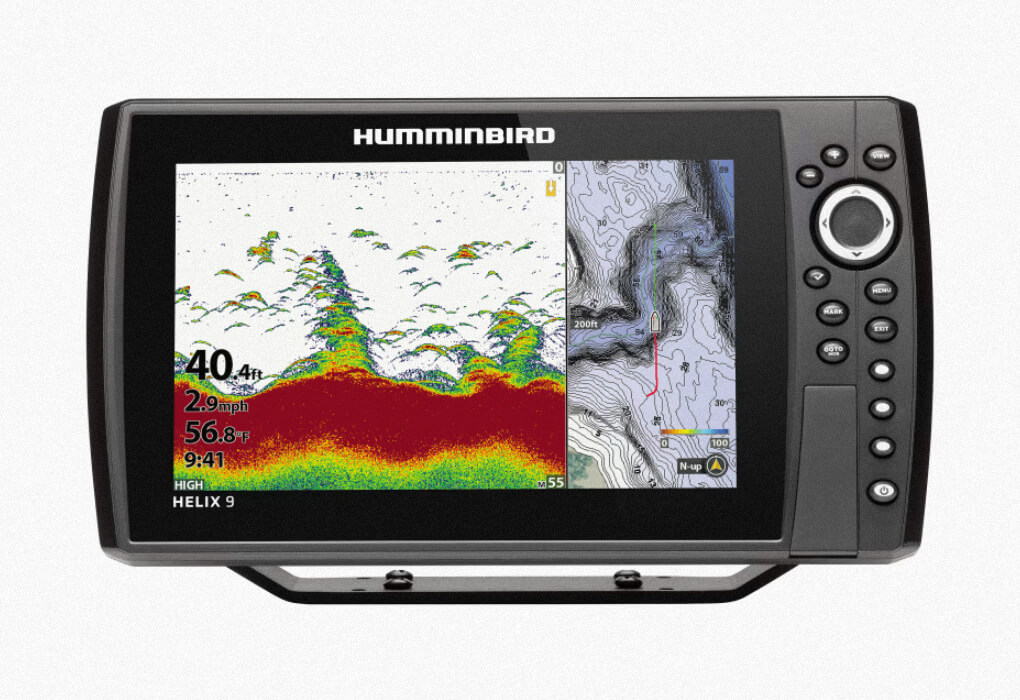
Specs
- Sonar Type: Down Imaging, Side Imaging, Dual Spectrum CHIRP, MEGA Imaging, MEGA 360 Imaging, and MEGA Live Imaging
- Screen Sizes: 5”, 7”, 8”, 9”, 10”, 12”, and 15”
- Resolution: 1024 x 600 pixels
Pros
Cons
Why We Chose It
The Humminbird Helix Series is hands-down the best Humminbird fish finder because it gives average anglers an extreme advantage with the many features they need at a surprisingly affordable price.
I was shocked that Humminbird had down imaging, side imaging, and Dual Beam Plus Sonar in the Helix series. The larger models also have the One-Boat Network system.
This means you can control EVERYTHING with your Helix fish finder from bow to stern, your Minn Kota trolling motor to the Minn Kota Talons (it’s the same concept as Lowrance does with the much more expensive HDS PRO).
In my opinion, the best thing about the Helix models is the numerous screen size options; you can select the perfect size screen whether you’re fishing from a large or small boat.
The screen size you choose determines the features your unit will have. If you want One-Boat Networking and other high-end features, you’ll have to choose a 7” screen or larger.
Another feature that helps this model stand out is the spectacular sonar options.
You can choose a Helix model with a transducer that has all the traditional sonar options, such as down imaging, side imaging, and Dual Spectrum CHIRP.
Even better, some of the larger screen models (8” screen and larger) are compatible with Humminbirds professional-level sonars:
- MEGA Imaging
- MEGA 360 Imaging
- MEGA Live Imaging
You’ll see what other anglers miss with the Humminbird Helix without paying as much as they did!
While I believe this is a truly great sonar system, I wouldn’t be being honest if I didn’t mention its cons.
The first one that stood out to me was some of the Helix models don’t offer the most detailed mapping.
This means if you’re a tournament angler, you’ll want to get the Humminbird Solix or Humminbird Apex because they have better GPS and mapping.
I was also confused as to which model I was actually buying. It felt like I needed a Ph.D. in Humminbird interpretation to decipher the code.
Here’s what I mean:
- HELIX 10 CHIRP MEGA DI+ GPS G4N
- HELIX 10 CHIRP MEGA DI+ GPS G4N CHO
- HELIX 10 CHIRP MEGA SI+ GPS G4N
- HELIX 10 CHIRP MEGA SI+ GPS G4N CHO
- HELIX 10 CHIRP MEGA DI+ GPS G3N
- HELIX 10 CHIRP MEGA DI+ GPS G3N CHO
- HELIX 10 CHIRP MEGA SI+ GPS G3N
- HELIX 10 CHIRP MEGA SI+ GPS G3N CHO
Yeah, I’m still not sure what all the letters mean, and I’ve spent hours researching this unit!
The units above all look the same because they are the same screen size, but each one has different sonar options, and it’s left to us, as the customer, to figure out what the abbreviations mean without much help from Humminbird or the retailer.
However, since it doesn’t actually take a Ph.D. to figure out the abbreviations, and many of the Helix model’s built-in mapping can quickly be upgraded with LakeMaster and CoastMaster maps, the Humminbird Helix Series is the best fish finder made by Humminbird for the price.
If you’re an average angler looking to gain an edge over the fish, don’t hesitate to purchase a Helix fish finder today.
Take a deep dive into the Helix Series by checking out our full reviews below:
- Humminbird Helix 5 review
- Humminbird Helix 7 review
- Humminbird Helix 9 review
- Humminbird Helix 10 review
Garmin Striker Cast
BEST CASTABLE UNIT
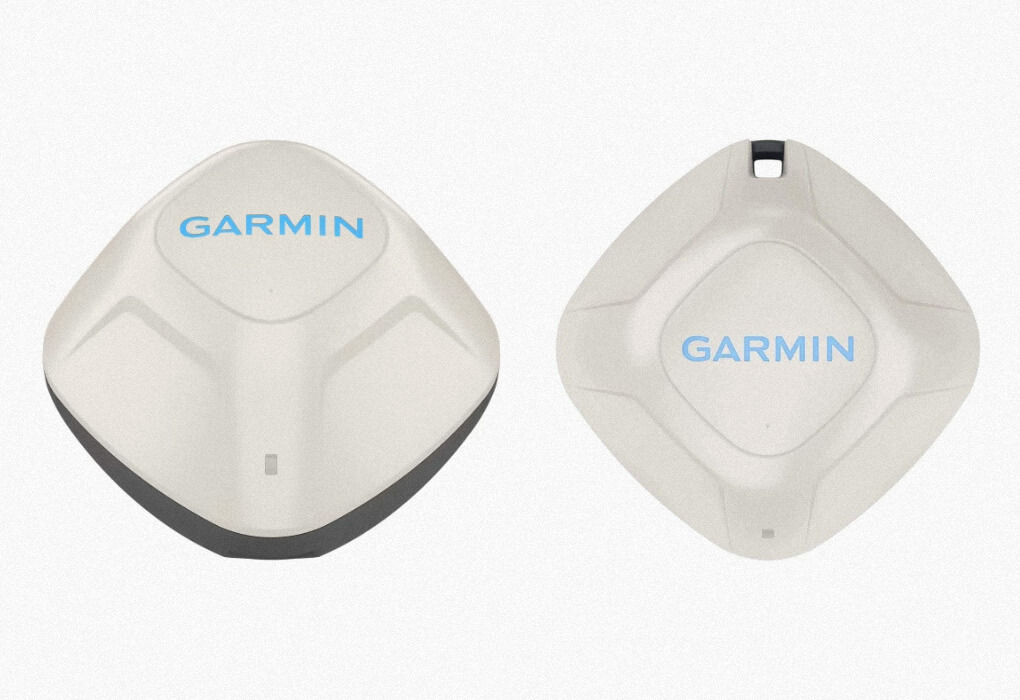
Specs
- Sonar Type: 2D CHIRP
- Screen Sizes: The size of your smartphone or tablet
- Resolution: The resolution of your smartphone or tablet
Pros
Cons
Why We Chose It
The Garmin Striker Cast is the best castable sonar option for shore anglers who love to fish ALL DAY, every day.
It’s a compact fish finder that will help you find where the fish are hanging out near the shore within minutes of taking it out of the box and connecting it via Bluetooth to your phone or tablet.
You’ll need to get the Striker Cast app, which is free to download and easy to navigate. Plus, you’ll get access to some of Garmin’s high-quality mapping with the GPS model but remember this is still a basic sonar unit.
For beginners, I think FishID is a really cool feature. When FishID is enabled, it’s easy to tell the difference between a stick and a fish because the program automatically puts a fish icon on the arches that are fish.
The aspect I love the most is how ridiculously portable it is. Whether you’re bank fishing, ice fishing, or kayak fishing, this little unit won’t take up much room. It easily fits in a coat pocket or a large tackle box.
As cool as the Garmin Striker Cast is, it’s by no means perfect after all; it’s a budget unit, so it doesn’t have all the mind-blowing features of the Echomap UHD2, but it is incredibly comparable in features and price to the Striker 4.
However, my biggest concern is that it’s unreliable when the conditions aren’t perfect. Small waves can cause your Bluetooth signal to disconnect, especially when you cast it near its 200’ range.
Overall, the Garmin Striker Cast is a spectacular unit for shore anglers because it’s inexpensive and helps you find fish you would overlook without it.
If you want to take your shore fishing to the next level, purchase a Garmin Striker Cast.
Check out our full Garmin Striker Cast review to get the entire rundown on this unit or discover the other castable fish finders.
Lowrance Elite FS
BEST FISH FINDER FOR AVID ANGLERS
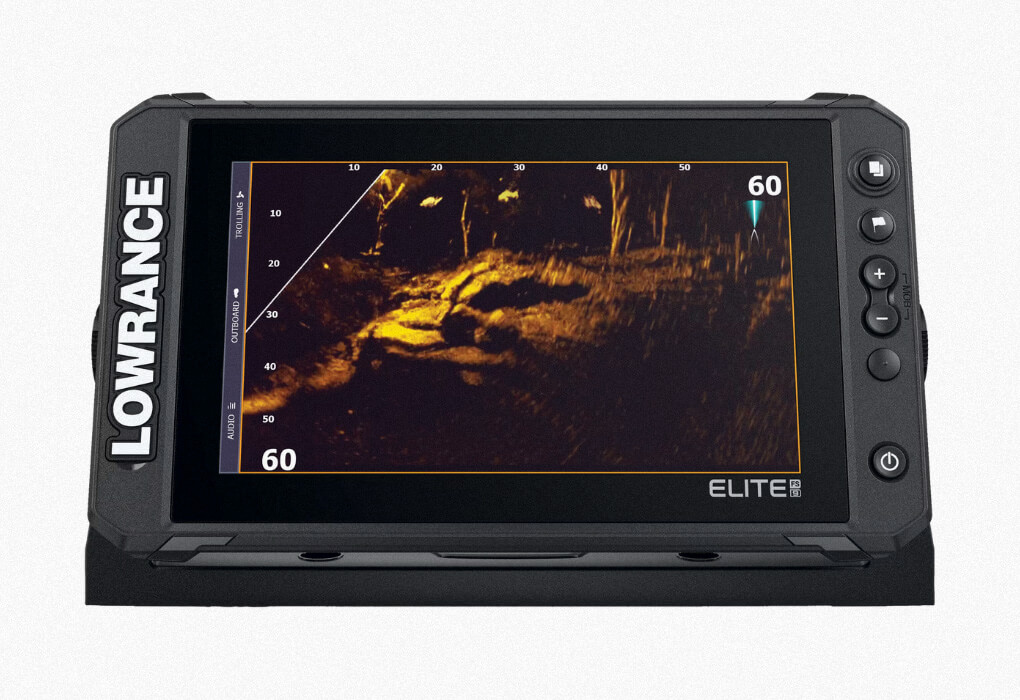
Specs
- Sonar Type: Active Imaging, Downscan, Sidescan, CHIRP, and ActiveTarget compatible
- Screen Sizes: 7” or 9”
- Resolution: 800 x 480 pixels
Pros
Cons
Why We Chose It
The Lowrance Elite FS is one of the best fish finders because the average angler can take it out of the box and use it to locate fish immediately.
It’s also compatible with high-end features like Active Imaging, which gave me one of the clearest sonar readings I’ve ever seen & ActiveTarget, which is Lowrance’s version of Garmin Panoptix Livescope.
After testing this out, I decided “full-service” is what FS stands for, not Fishing System.
Active Imaging and FishReveal are two of the best sonar features I’ve ever seen, and it blows my mind they both come with this unit.
However, if you’re really looking to up your game and have $1,600 burning a hole in your pocket, upgrade the sonar to include Active Target.
You won’t regret it! Well, until your house payment is due…
The clarity of the 800×480 high-resolution, responsive touchscreen was outstanding. It was easy to see and navigate the menus due to their minimalistic design, which makes it simple for the less tech-savvy anglers.
During my research, I learned that the Elite FS was the first Ethernet networking fish finder ever, which is a fancy way of saying it can share data between local fish finders without swapping MicroSD cards.
This is a great feature if you plan to use multiple units, but doesn’t matter if you only buy a single Lowrance unit.
Hold your horses; the fat lady hasn’t sung, and I’m not finished with the benefits yet. You get thousands of inland and coastal maps with C-Map Contour+.
You can also upgrade to C-Map Genesis with the purchase of an SD card, so you’ll have 1-foot contours and bottom hardness maps.
I found several upsides to the Lowrance Elite FS while testing, but I also came across a few downsides, such as frustration when setting it up, lack of screen size options, and it’s pretty darn expensive.
When installing it to test it, I discovered it needed heavier gauge wire than was in my boat because it would turn on, and the screen would flicker.
Once I switched to larger gauge wires, the problem was solved, and a professional installer would have known better.
The 7” screen is great for a kayak, but I know some anglers need a 12” or larger screen, so they can watch the game when they’re not catching fish.
However, the Elite FS does not offer any units larger than 9”, which is plenty big for the average angler.
When I consider the features that come standard on the Elite FS, I can see why it’s so expensive, but that doesn’t mean I have to like it.
Even after nitpicking the Lowrance Elite FS to death, it’s still one of the best units I have ever tested.
However, it’s probably overkill for beginner anglers; but it’s perfect for intermediate anglers who want to upgrade to high-end features like ActiveTarget in the future.
Read the full review of the Lowrance Elite FS to get all our thoughts on this sonar unit.
Garmin Livescope Plus Ice Fishing Bundle
BEST ICE-FISHING FISH FINDER
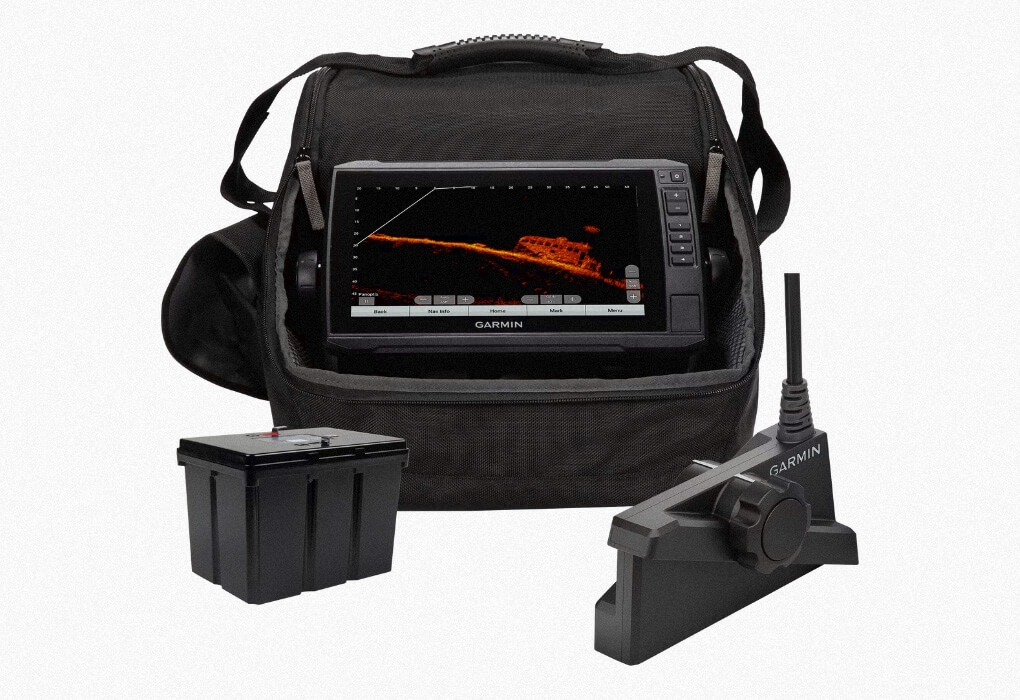
Specs
- Sonar Type: Livescope
- Screen Sizes: 9”
- Resolution: 800 x 480 pixels
Pros
Cons
Why We Chose It
If you want the best ice-fishing fish finder look no further than the Garmin Livescope Plus Ice Fishing Bundle. It feels illegal because you’re spying on the fish without them knowing it.
Never again will you have to guess where the best place to drill the next hole is.
The sonar is the star of the show of all the things to love about this unit. Panoptix Livescope Plus is the best of the best live sonar because it turns fishing into a video game.
I can see fish nearly 200’ away and how they react to my lure.
Not to mention, it’s easy to see the sonar reading on the 9” screen. I don’t struggle to see the 800 x 400-pixel screen of the Garmin Echomap UHD when using downward-facing sonar to see fish below or forward-facing sonar to see the fish around the hole.
I appreciate how simple it is to switch between the two modes. You only have to press a couple of buttons on the touchscreen to switch. You never have to switch transducers!
This makes it very easy to transport in the carrying case, which holds everything from the Echomap UHD unit, Livescope Plus transducer, and the lightweight lithium-ion battery.
As ridiculously awesome as the Garmin Livescope Plus Ice-Fishing Bundle is, I managed to find some cons when testing it.
The obvious con is the high cost; if you want the latest and greatest sonar tech, you’ll have to cough up over $3,000, which will slim down your wallet.
If you’re like me, it’s nearly impossible to justify that price for sonar you can only use during the winter.
The last drawback I’ll discuss is the touchscreen with keyed assist. It’s very difficult to operate wearing warm waterproof gloves and doesn’t respond well when your hands are cold or wet; not a great combo for ice-fishing scenarios.
Other than the high cost and small touchscreen struggles, the Garmin Livescope Plus Ice-Fishing Bundle is perfect for the dedicated ice angler.
The top-of-the-line sonar ensures your money is well spent on the best ice-fishing fish finder.
Dive deeper by checking out our Garmin Panoptix Livescope Review.
Garmin Striker 4
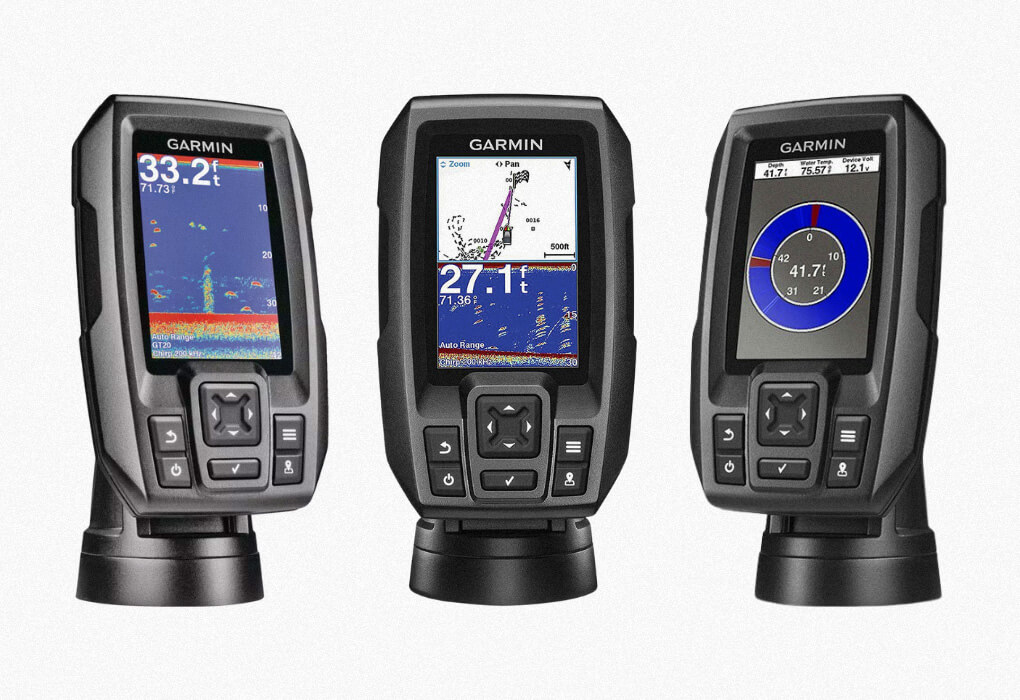
Specs
- Sonar Type: CHIRP
- Screen Sizes: 3.5” or 4.3”
- Resolution: 480 x 320 pixels
Pros
Cons
Why We Chose It
The Garmin Striker 4 is affordable and extremely user-friendly. It was the first fish finder I ever bought and is still mounted on my Nucanoe Frontier 12 fishing kayak.
The Striker 4 can be bought in a few different models with a traditional chirp option; the Striker Plus has dual beam sonar, and the portable kit has a cover for ice fishing, so the Striker 4 has every beginner angler covered no matter your style of fishing.
I was amazed at how simple this unit was to set up and use when I first installed it on my kayak. I had never installed a fish finder before, and it only took about 30 minutes to have it ready to go.
Understanding the capabilities and navigating to the various pages might have taken another 30 minutes or so, but within an hour, I felt comfortable enough with it to hit the water.
This unit is great for beginners and casual anglers because it’s easy to figure out, the technology is not complicated, and the buttons are self-explanatory.
I bought this unit for my fishing kayak because it’s small and portable, so if you also fish out of a small boat, I strongly encourage you to get the Striker 4.
However, there are some downfalls that come along with having a basic fish finder with a small screen we found out while doing Striker 4 and Humminbird PiranhaMAX review.
Let’s start with the small, hard-to-see screen. If you have terrible eyesight, this probably isn’t the unit for you. It’s about a 4” screen, whether you get the Striker 4 or the Striker Plus 4.
Another drawback is the lack of quality maps. When I set a waypoint on my Striker 4, it’s on a mark on a white screen.
To help make up for this, you can use Garmin Quickdraw Live Contour mapping on the Striker Plus 4, but it still doesn’t give you a map of the lake you’re fishing.
For me, the biggest con is that I had to buy a different model to get the latest features from Garmin.
The Striker 4 is about as basic as it gets, much like the Striker Cast, so while it’s simple to navigate and use if you’re a serious angler, you’ll want to upgrade to a unit with more and better features within a year or two.
At least, that’s what I did.
However, it’s hard to rag on this unit too much, especially at this ridiculously low price. When you factor in the price vs. features, it’s simple; every weekend angler with a small boat or kayak should own one of these.
It sure helped me find more spots to fish in my kayak.
Read our full Garmin Striker 4 review to completely understand everything this unit offers.
Garmin Striker Vivid
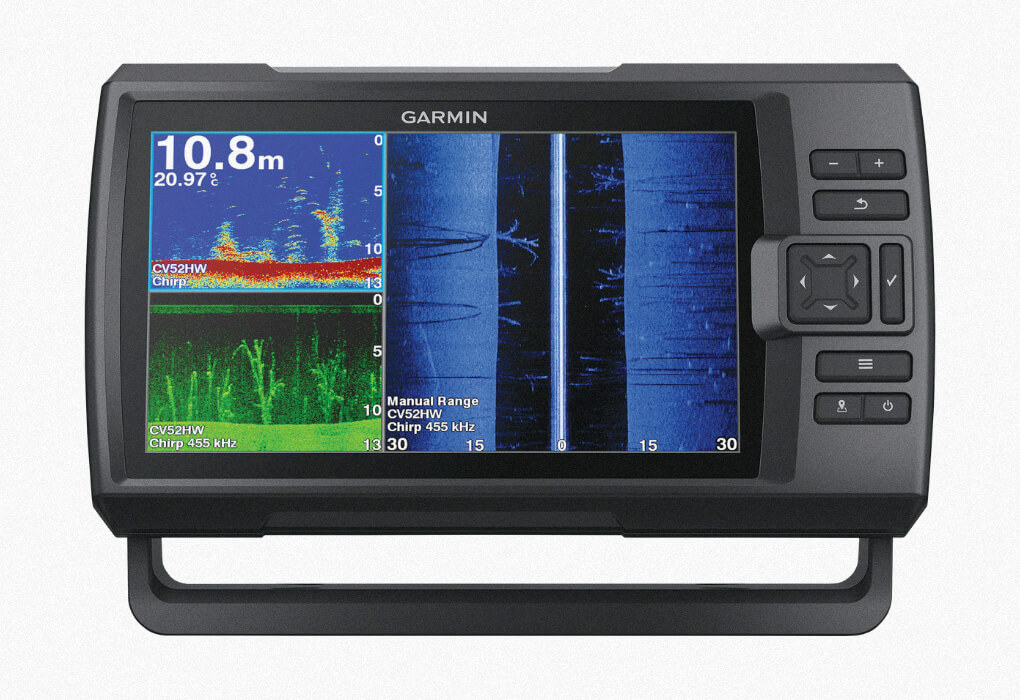
Specs
- Sonar Type: Traditional Dual-frequency CHIRP and ClearVU
- Screen Sizes: 4”, 5”, 7”, 9”
- Resolution: 800 x 480 pixels
Pros
Cons
Why We Chose It
The Garmin Striker Vivid perfectly balances price and features for casual and intermediate-level anglers.
No doubt about it, the Striker Vivid is a step above the Striker 4, with larger screen options, better sonar, and better mapping; however, you could spend a little bit more and get an Echomap UHD2 that has even better features.
For most anglers, though, the Vivid will offer all the features you need while on the water.
With the HD display and enhanced color palettes, I could see the difference between the structure and the fish, especially when I engaged the FishID feature.
Finding my favorite fishing spots was easy with waypoints and GPS. When visiting new areas, I use Quickdraw Contour mapping for an accurate depth reading of the area.
Whether your hands are cold or wet, you won’t have to worry about a finicky touchscreen with the Striker Vivid because it’s button controlled, so you can still easily use your fish finder in any weather condition.
As awesome as this unit is, there are a couple of downfalls that I need to make you aware of.
The so-called mapping bothers me the most. Yes, you can create contour lines of the spot you’re fishing, but you don’t get an actual map.
The sonar reveals the depth changes as you move on a blank yellow screen. I’d much rather have an actual map of the lake.
The other shortcoming I found was this unit is only slightly better than the Garmin Striker 4 Plus because the Vivid has better sonar options. It doesn’t really stand out from the other Garmin units with any special features.
However, anglers of various skill levels will find this unit an excellent addition to their boat without having to choose between a new truck and a fish finder.
The Striker Vivid has all the features average anglers need without the ones that overcomplicate everything.
If you’re the angler who needs something slightly more advanced than a Striker 4, but you’re reluctant to leap all the way to an expensive UHD 2, the Striker Vivid is the unit you should check out.
Go ahead and read our expert Garmin Striker Vivid review for more details on this unit.
Lowrance HDS PRO
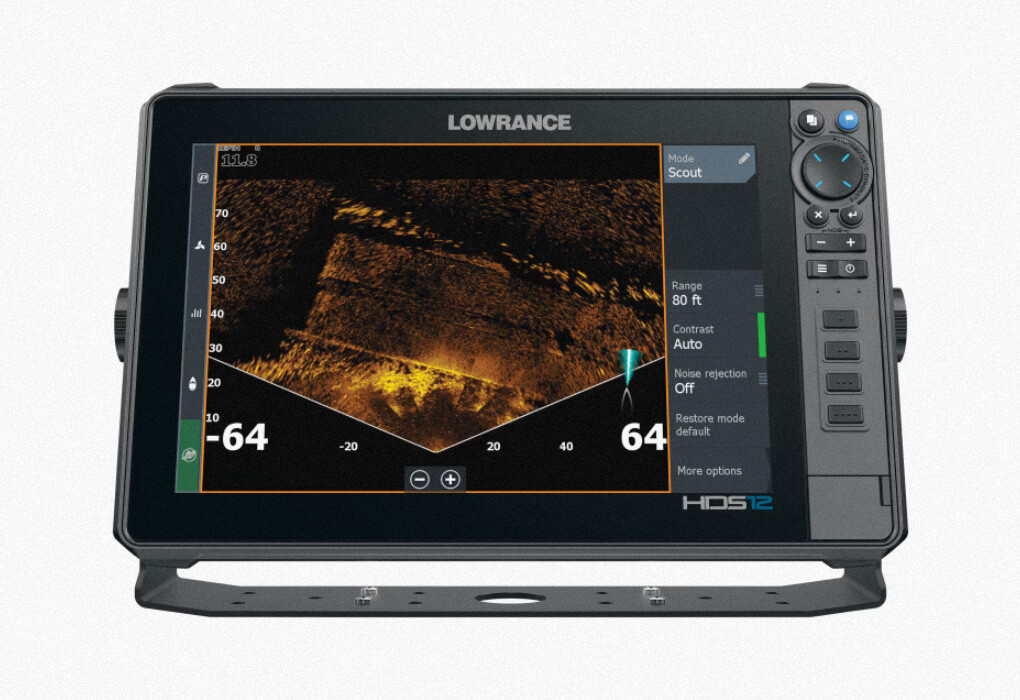
Specs
- Sonar Type: Active Imaging HD, SideScan, Downscan, and ActiveTarget 2 compatible
- Screen Sizes: 9”, 10”, 12”, and 16”
- Resolution: 1280 x 720 pixels
Pros
Cons
Why We Chose It
The Lowrance HDS PRO wraps the best sonar, mapping, and screens by Lowrance into one package for tournament anglers.
This unit is the upgraded model of the Lowrance HDS Live, which shattered my expectations when I tested it.
This unit is a no-brainer for tournament anglers. It gives you ultimate control of your Lowrance Ghost trolling motor, Power Poles and sends information to the other Lowrance units on your boat.
The sonar advancements in recent years are staggering, and they keep improving with ActiveTarget 2. It’s like you’re seeing what the fish see.
You get a live view of wherever you point the transducer so you can see exactly how the fish react to your presentation and adjust to get more bites.
Sadly, HDS Live is only compatible with ActiveTarget, so you’ll have to upgrade to HDS PRO to get Active Target 2, but when you do, you’ll have the latest and greatest sonar from Lowrance installed on your boat.
Speaking of the latest and greatest, the SolarMAX HD display eliminates the days of fighting the sun’s glare to see your fish finder screen.
When testing it, I had no trouble seeing the screen on the HDS Live, and I would expect even more from the HDS PRO.
There’s no arguing that this is the best Lowrance fish finder in terms of features. But it has a couple of drawbacks, as to why not everyone should buy it.
The most obvious is the high price. This unit will cost you at least $2,000 for the 9” screen and more if you want the larger screens. Then it’ll cost you another $1,600+ for ActiveTarget 2.
You better be cashing in every tournament to pay for it all!
The other downside is that you’d be wasting your money on features you won’t ever use; at least, that’s what happened to me while testing the Lowrance HDS Live.
To get total control of your boat, you must have a Ghost trolling motor and Power Poles installed. If you have a different brand of trolling motor or shallow water anchor, you won’t be able to take advantage of all the benefits of this depth finder.
Despite the cons I ran into, I have yet to find a better Lowrance fish finder than the Lowrance HDS PRO. It’s targeted towards tournament and dedicated anglers with excellent credit or a stack of cash in their wallet.
So if that’s you, go ahead and grab a unit or two to install on your boat!
We got our hands on some of the best fish finders on the market. Click the video above to watch our hands-on review!
Testing Procedures
While testing the best fish finders on the market, I kept these three factors in mind to help with ranking them for this article. They are-
- Price: The features are what most often determine the price range. The size of the screen and the types of sonar are the two biggest factors.
I compared the price to the number of features each fish finder offered to help make my decisions.
- User-Friendliness: I consider myself a fairly tech-savvy person, but I don’t like overly complicated things. I like to live by the motto of Lynard Skynard, “Mama told me to be a simple man,” and I think fish finders should be as simple as possible.
However, as the number of features increases, so does the complexity, so there’s a fine line to walk.
- Upgradability: My first fish finder was a Garmin Striker 4, an excellent fish finder for beginners; however, I quickly outgrew its capabilities and needed to upgrade, but I had to buy a new unit.
So now I look for upgradeable fish finders with add-on features or software updates.
Frequently Asked Questions
What brand fish finders are the best?
Garmin, Lowrance, and Humminbird brand fish finders are the best for fishing.
What is the easiest fish locator to use?
The Garmin Striker 4 is the easiest fish locator to use.
What is the best fish finder under $700?
The best fish finder under $700 is the Lowrance Hook Reveal.
Final Thoughts
Choosing the right fish finder is not easy. It’s an expensive purchase, and it’s something that you want to last you a long time.
Many factors go into this decision, and a lot of technology behind how they work is complicated. This guide was intended to clear up some of your confusion and point you in the right direction.
All of the fish finders reviewed above are great options; it’s just about choosing the one that makes the most sense for you.
If you want the best fish finder for the average angler, I recommend the Lowrance Hook Reveal because it offers the most features for an affordable price.
If you’re like me, you just want something to perform its duty without all the smoke and mirrors. That fish finder will do the trick.
Let us know your favorite fish finder in the comments!




